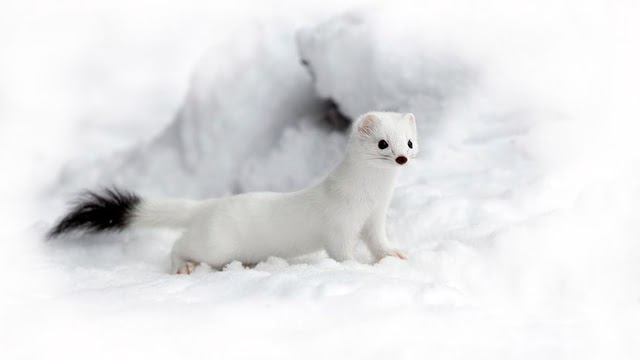Quck answer
Stoats and weasels are both small, carnivorous mammals that belong to the family Mustelidae. However, there are several differences between them:
| Stoat | Weasel |
|——-|——–|
| Larger and longer body | Smaller and shorter body |
| Black tip on tail | No black tip on tail |
| Can change color from brown to white in winter | No change in color |
| Prefers to live in open fields and grasslands | Prefers to live in woodland areas |
| Eats larger prey such as rabbits and birds | Eats smaller prey such as rodents and insects |
In summary, while stoats and weasels may look similar, their size, tail color, ability to change color, habitat, and prey preferences all differ.
Wild Animals

At first glance, stoats may resemble weasels, but they are two distinct species. Stoats are larger than weasels, and they are known for their ability to hypnotize rabbits. Photography by Linda Lyon/Getty Images.
Many people mistake stoats for weasels, as they share several similarities. Both are tiny, brown, quick, and ferocious mustelids with slender bodies and short legs.
However, stoats are much larger than weasels and have a unique black tail tip, according to Charli Burbidge, co-founder of Petz, a UK-based website. She adds that stoats have elongated necks and skulls, round, black, protruding eyes, short, flat ears, and enormous claws compared to their digits.
Stoats possess an intriguing superpower that differentiates them from weasels: their agility. They usually attack prey like rats, mice, possums, birds, and squirrels by biting them on the neck. However, when hunting rabbits, stoats use their clever minds to hypnotize the creatures before pouncing on them. The stoat on the hunt will spin, jump, and twist frenetically, attracting the rabbit’s attention with its manic behavior. As the stoat approaches, the rabbit remains transfixed and unable to flee until it is too late.
Would you like to learn more about these fascinating creatures? Here are five more fun facts about the stoat, which is typically found along the English countryside.
1. They Change Color in Winter
In the summer, the stoat’s coat is reddish-brown with a creamy tummy, but it turns completely white in the winter. “This is to help them stay less noticeable,” Burbridge explains. “However, their black-tipped tail remains throughout the seasons.” The winter coat is thicker than the summer coat, keeping the stoat warm and camouflaged in the snow.
When the stoat is in its winter coat, it is also known as an ermine. In moderately cold climates, the fur becomes only partly white. Unfortunately, the stoat’s winter coat is especially prized by the fur trade, and used to trim coats and stoles.

During the winter months, the stoat’s coat changes to a thick, lush white to help keep it warm and camouflage it in the snow. Fabrizio Moglia/Getty Images.
2. They Don’t Make Great Pets
While it is technically possible to keep a stoat as a pet, it is not recommended. Stoats may be extremely adorable, but they are not compatible with cats, dogs, small pets, or children. Stoats cling to the backs of their prey’s necks, and victims are usually unable to fight back with their paws, claws, or wings. Eventually, the neck wound widens until the blood flow is unstoppable.
Cats have a greater chance of surviving stoat attacks than dogs. Mustelids cannot climb, and cats can often reach the back of their necks with their claws, which dogs find more difficult. Furthermore, if you discover stoats for sale, they are likely illegally captured wild specimens. If you purchase one, you will be promoting illegal and harmful wildlife trade.
3. The Stoat: An Invasive Alien Species
The International Union for Conservation of Nature named the stoat as one of the 100 worst invasive alien species in the world in 2000. Even though the list mainly consists of plants and insects, the cute little stoat is among the top 10 invasive mammals.
Why are they so invasive? While stoats are native to Asia, Europe, and North America, they were introduced to New Zealand and Britain to help control the rabbit population. However, their introduction had a devastating effect on the bird and rodent species, as they are opportunistic predators that can adapt to most climates and thrive in many environments. Stoats move rapidly and check every available crevice or burrow for food, often climbing trees to find bird nests.

Stoats are vicious predators, biting their prey in the neck until they bleed out.
4. A Stoat Pregnancy Lasts Around 300 Days
Stoats usually have between five and 15 kits at a time and only give birth once in their life, which is an average of four to six years. Males do not help raise the babies. The kits are born blind and toothless, covered in white-pink fur that changes as they grow older. They gain their sight around four weeks of age.
5. Stoats Steal Their Prey’s Dens
Male and female stoats live separately in their dens and have several dens that they use at the same time. Their den sites are well-hidden, typically in the nests of prey they’ve killed and taken over, such as holes in tree trunks and rabbit burrows. Stoats check every burrow and hollow they see, and if they find a ground-nesting bird, it has very little chance to escape.
Now That’s Interesting
The origin of the word “stoat” likely comes from either the Dutch word “stout,” meaning naughty, or the Gothic word “stautan,” meaning to push.
FAQ
1. What are stoats and weasels?
Stoats and weasels are both small mammals that belong to the mustelid family. They are both carnivorous and have long, slender bodies. Stoats are slightly larger and have a longer tail than weasels.
2. How can you tell the difference between a stoat and a weasel?
The easiest way to tell the difference between a stoat and a weasel is by their size and tail length. Stoats are larger and have a longer tail, while weasels are smaller and have a shorter tail. Stoats also have a distinctive black tip on their tail, whereas weasels have a brown tip.
3. What habitats do stoats and weasels live in?
Stoats and weasels are found in a range of habitats, including forests, grasslands, and wetlands. They are also common in farmland and suburban areas.
4. What do stoats and weasels eat?
Both stoats and weasels are carnivorous and feed on small animals such as rodents, rabbits, and birds. They are also known to prey on insects and reptiles.
5. Do stoats and weasels have any predators?
Yes, stoats and weasels have a number of predators, including birds of prey, foxes, and domestic cats. They are also at risk from habitat destruction and hunting by humans.
6. Are stoats and weasels endangered?
Neither stoats nor weasels are currently considered endangered, but they are still at risk from habitat destruction and hunting. Both species are found in many parts of the world and are relatively common, although they may be less abundant in some areas.





Leave a Reply